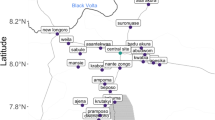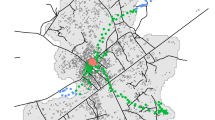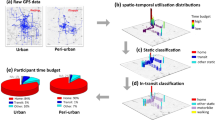Abstract
Scalable exposure assessment approaches that capture personal exposure to particles for purposes of epidemiology are currently limited, but valuable, particularly in low-/middle-income countries where sources of personal exposure are often distinct from those of ambient concentrations. We measured 2 × 24-h integrated personal exposure to PM2.5 and black carbon in two seasons in 402 participants living in peri-urban South India. Means (sd) of PM2.5 personal exposure were 55.1(82.8) µg/m3 for men and 58.5(58.8) µg/m3 for women; corresponding figures for black carbon were 4.6(7.0) µg/m3 and 6.1(9.6) µg/m3. Most variability in personal exposure was within participant (intra-class correlation ~20%). Personal exposure measurements were not correlated (Rspearman < 0.2) with annual ambient concentration at residence modeled by land-use regression; no subgroup with moderate or good agreement could be identified (weighted kappa ≤ 0.3 in all subgroups). We developed models to predict personal exposure in men and women separately, based on time-invariant characteristics collected at baseline (individual, household, and general time-activity) using forward stepwise model building with mixed models. Models for women included cooking activities and household socio-economic position, while models for men included smoking and occupation. Models performed moderately in terms of between-participant variance explained (38–53%) and correlations between predictions and measurements (Rspearman: 0.30–0.50). More detailed, time-varying time-activity data did not substantially improve the performance of the models. Our results demonstrate the feasibility of predicting personal exposure in support of epidemiological studies investigating long-term particulate matter exposure in settings characterized by solid fuel use and high occupational exposure to particles.
This is a preview of subscription content, access via your institution
Access options
Subscribe to this journal
Receive 6 print issues and online access
$259.00 per year
only $43.17 per issue
Buy this article
- Purchase on Springer Link
- Instant access to full article PDF
Prices may be subject to local taxes which are calculated during checkout

Similar content being viewed by others
References
World Health Organization. Review of evidence on health aspects of air pollution - REVIHAAP Project. 2013. http://www.euro.who.int/en/health-topics/environment-and-health/air-quality/publications/2013/review-of-evidence-on-health-aspects-of-air-pollution-revihaap-project-final-technical-report.
U.S. EPA. Integrated Science Assessment for Particulate Matter. 2009 EPA/600/R-08/139F.
Cohen AJ, Brauer M, Burnett R, Anderson HR, Frostad J, Estep K, et al. Estimates and 25-year trends of the global burden of disease attributable to ambient air pollution: an analysis of data from the Global Burden of Diseases Study 2015. Lancet. 2017;389:1907–18.
Tonne C. A call for epidemiology where the air pollution is. Lancet Planet Heal. 2017;1:e355–e356.
Özkaynak H, Baxter LK, Dionisio KL, Burke J. Air pollution exposure prediction approaches used in air pollution epidemiology studies. J Expo Sci Environ Epidemiol. 2013;23:566–72.
Marshall JD, Nethery E, Brauer M. Within-urban variability in ambient air pollution: comparison of estimation methods. Atmos Environ. 2008;42:1359–69.
Lane KJ, Levy JI, Scammell MK, Patton AP, Durant JL, Mwamburi M, et al. Effect of time-activity adjustment on exposure assessment for traffic-related ultrafine particles. J Expo Sci Environ Epidemiol. 2015;25:506–16.
Deffner V, Küchenhoff H, Maier V, Pitz M, Cyrys J, Breitner S, et al. Personal exposure to ultrafine particles: two-level statistical modeling of background exposure and time-activity patterns during three seasons. J Expo Sci Environ Epidemiol. 2016;26:17–25.
Glasgow ML, Rudra CB, Yoo E-H, Demirbas M, Merriman J, Nayak P, et al. Using smartphones to collect time–activity data for long-term personal-level air pollution exposure assessment. J Expo Sci Environ Epidemiol. 2016;26:356–64.
Steinle S, Reis S, Sabel CE. Quantifying human exposure to air pollution-Moving from static monitoring to spatio-temporally resolved personal exposure assessment. Sci Total Environ. 2013;443:184–93.
Isaacs K, McCurdy T, Glen G, Nysewander M, Errickson A, Forbes S, et al. Statistical properties of longitudinal time-activity data for use in human exposure modeling. J Expo Sci Environ Epidemiol. 2013;23:328–36.
McCracken JP, Schwartz J, Bruce N, Mittleman M, Ryan LM, Smith KR. Combining individual- and group-level exposure information. Epidemiology. 2009;20:127–36.
Tonne C, Salmon M, Sanchez M, Sreekanth V, Bhogadi S, Sambandam S, et al. Integrated assessment of exposure to PM 2.5 in South India and its relation with cardiovascular risk: design of the CHAI observational cohort study. Int J Hyg Environ Health. 2017;220:1081–8.
Kinra S, Radha Krishna K, Kuper H, Rameshwar Sarma K, Prabhakaran P, Gupta V, et al. Cohort Profile: Andhra Pradesh Children and Parents Study (APCAPS). Int J Epidemiol. 2014;43:1417–24.
Balakrishnan K, Sambandam S, Ramaswamy P, Ghosh S, Venkatesan V, Thangavel G, et al. Establishing integrated rural-urban cohorts to assess air pollution-related health effects in pregnant women, children and adults in Southern India: an overview of objectives, design and methods in the Tamil Nadu Air Pollution and Health Effects (TAPHE) s. BMJ Open. 2015;5:e008090–e008090.
Zanatta M, Gysel M, Bukowiecki N, Müller T, Weingartner E, Areskoug H, et al. A European aerosol phenomenology-5: Climatology of black carbon optical properties at 9 regional background sites across Europe. Atmos Environ. 2016;145:346–64.
Kumar MK, Sreekanth V, Salmon M, Tonne C, Marshall JD. Use of spatiotemporal characteristics of ambient PM 2.5 in rural South India to infer local versus regional contributions. Environ Pollut. 2018;239:803–11.
Sanchez M, Ambros A, Milà C, Salmon M, Balakrishnan K, Sambandam S, et al. Development of land-use regression models for fine particles and black carbon in peri-urban South India. Sci Total Environ. 2018;634:77–86.
Balakrishnan K, Sambandam S, Ramaswamy P, Mehta S, Smith KR. Exposure assessment for respirable particulates associated with household fuel use in rural districts of Andhra Pradesh, India. J Expo Sci Environ Epidemiol. 2004;14:S14–S25.
Sanchez M, Ambros A, Salmon M, Bhogadi S, Wilson R, Kinra S, et al. Predictors of daily mobility of adults in Peri-Urban South India. Int J Environ Res Public Health. 2017;14:783.
Salmon M, Milà C, Bhogadi S, Addanki S, Madhira P, Muddepaka N, et al. Wearable camera-derived microenvironments in relation to personal exposure to PM 2.5. Environ Int. 2018;117:300–7.
Snijders TAB, Berkhof J Diagnostic Checks for Multilevel Models. In: Handbook of Multilevel Analysis. New York: Springer New York, pp 141–75.
Wang M, Brunekreef B, Gehring U, Szpiro A, Hoek G, Beelen R. A New Technique for Evaluating Land-use Regression Models and Their Impact on Health Effect Estimates. Epidemiology. 2016;27:51–6.
R Core Team. R: A language and environment for statistical computing. R Foundation for Statistical Computing, Vienna, Austria. 2015. https://www.r-project.org/.
Nieuwenhuis R, Te Grotenhuis M, Pelzer B. Influence.ME: tools for detecting influential data in mixed effects models. R J. 2012;4:38–47.
Wickham H. tidyverse: Easily Install and Load ‘Tidyverse’ Packages. R package version 1.0.0. 2016. https://cran.r-project.org/package=tidyverse.
Wickham H. ggplot2: Elegant Graphics for Data Analysis. R package version 2.2.0. 2009. http://ggplot2.org.
Bates D, Maechler M, Bolker B, Walker S. Fitting linear mixed-effects models using lme4. J Stat Softw. 2015;67:1–48.
McCracken JP, Schwartz J, Diaz A, Bruce N, Smith KR. Longitudinal relationship between personal CO and personal PM2.5 among women cooking with woodfired cookstoves in Guatemala. PLoS One. 2013;8:e55670.
Dionisio KL, Howie SRC, Dominici F, Fornace KM, Spengler JD, Donkor S, et al. The exposure of infants and children to carbon monoxide from biomass fuels in The Gambia: a measurement and modeling study. J Expo Sci Environ Epidemiol. 2012;22:173–81.
Lee K, Bartell SM, Paek D. Interpersonal and daily variability of personal exposures to nitrogen dioxide and sulfur dioxide. J Expo Sci Environ Epidemiol. 2004;14:137–43.
Nethery E, Teschke K, Brauer M. Predicting personal exposure of pregnant women to traffic-related air pollutants. Sci Total Environ. 2008;395:11–22.
Nethery E, Leckie SE, Teschke K, Brauer M. From measures to models: an evaluation of air pollution exposure assessment for epidemiological studies of pregnant women. Occup Environ Med. 2008;65:579–86.
MacNeill M, Wallace L, Kearney J, Allen RW, Van Ryswyk K, Judek S, et al. Factors influencing variability in the infiltration of PM2.5 mass and its components. Atmos Environ. 2012;61:518–32.
Johannesson S, Gustafson P, Molnár P, Barregard L, Sällsten G. Exposure to fine particles (PM2.5 and PM1) and black smoke in the general population: personal, indoor and outdoor levels. J Expo Sci Environ Epidemiol. 2007;17:613–24.
Milà C, Salmon M, Sanchez M, Ambrós A, Bhogadi S, Sreekanth V, et al. When, where, and what? characterizing personal PM2.5 exposure in Periurban India by integrating GPS, wearable camera, and ambient and personal monitoring data. Environ Sci Technol. 2018;52:13481–90.
Carter E, Archer-Nicholls S, Ni K, Lai AM, Niu H, Secrest MH, et al. Seasonal and diurnal air pollution from residential cooking and space heating in the Eastern Tibetan Plateau. Environ Sci Technol. 2016;50:8353–61.
Sarnat JA, Brown KW, Schwartz J, Coull BA, Koutrakis P. Ambient gas concentrations and personal particulate matter exposures. Epidemiology. 2005;16:385–95.
Michikawa T, Nakai S, Nitta H, Tamura K. Validity of using annual mean particulate matter concentrations as measured at fixed site in assessing personal exposure: an exposure assessment study in Japan. Sci Total Environ. 2014;466–7:673–80.
Miller KA, Spalt EW, Gassett AJ, Curl CL, Larson TV, Avol E, et al. Estimating ambient-origin PM2.5 exposure for epidemiology: observations, prediction, and validation using personal sampling in the Multi-Ethnic Study of Atherosclerosis. J Expo Sci Environ Epidemiol. 2019;29:227–37.
Nieuwenhuijsen MJ, Donaire-Gonzalez D, Rivas I, de Castro M, Cirach M, Hoek G, et al. Variability in and agreement between modeled and personal continuously measured black carbon levels using novel smartphone and sensor technologies. Environ Sci Technol. 2015;49:2977–82.
Montagne D, Hoek G, Nieuwenhuijsen M, Lanki T, Pennanen A, Portella M, et al. Agreement of land use regression models with personal exposure measurements of particulate matter and nitrogen oxides air pollution. Environ Sci Technol. 2013;47:8523–31.
Wilson WE, Brauer M. Estimation of ambient and non-ambient components of particulate matter exposure from a personal monitoring panel study. J Expo Sci Environ Epidemiol. 2006;16:264–74.
Balakrishnan K, Parikh J, Sankar S, Padmavathi R, Srividya K, Venugopal V, et al. Daily average exposures to respirable particulate matter from combustion of biomass fuels in rural households of Southern India. Environ Health Perspect. 2002;110:1069–75.
Pant P, Habib G, Marshall JD, Peltier RE. PM 2.5 exposure in highly polluted cities: a case study from New Delhi, India. Environ Res. 2017;156:167–74.
Van Vliet EDS, Asante K, Jack DW, Kinney PL, Whyatt RM, Chillrud SN, et al. Personal exposures to fine particulate matter and black carbon in households cooking with biomass fuels in rural Ghana. Environ Res. 2013;127:40–8.
Nayek S, Padhy PK. Daily personal exposure of women cooks to respirable particulate matters during cooking with solid bio-fuels in a rural community of West Bengal, India. Aerosol Air Qual Res. 2017;17:245–52.
McCreddin A, Alam MS, McNabola A. Modelling personal exposure to particulate air pollution: an assessment of time-integrated activity modelling, Monte Carlo simulation and artificial neural network approaches. Int J Hyg Environ Health. 2015;218:107–16.
Meng QY, Spector D, Colome S, Turpin B. Determinants of indoor and personal exposure to PM2.5 of indoor and outdoor origin during the RIOPA study. Atmos Environ. 2009;43:5750–8.
Rivas I, Donaire-Gonzalez D, Bouso L, Esnaola M, Pandolfi M, de Castro M, et al. Spatiotemporally resolved black carbon concentration, schoolchildren’s exposure and dose in Barcelona. Indoor Air. 2016;26:391–402.
McCracken JP, Wellenius GA, Bloomfield GS, Brook RD, Tolunay HE, Dockery DW. et al. Household air pollution from solid fuel use. Glob. Heart. 2012;7:223–34.
Acknowledgements
The research leading to these results received funding from the European Research Council under ERC Grant Agreement number 336167 for the CHAI Project. The third wave of data collection and village socio-demographic surveys for the APCAPS study were funded by the Wellcome Trust (Grant 084674/Z). C.T. was funded through a Ramón y Cajal fellowship (RYC-2015–17402) awarded by the Spanish Ministry of Economy and Competitiveness. We thank all participants and study teams of the APCAPS and CHAI studies.
Author information
Authors and Affiliations
Corresponding author
Ethics declarations
Conflict of interest
The authors declare that they have no conflict of interest.
Additional information
Publisher’s note: Springer Nature remains neutral with regard to jurisdictional claims in published maps and institutional affiliations.
Supplementary information
Rights and permissions
About this article
Cite this article
Sanchez, M., Milà, C., Sreekanth, V. et al. Personal exposure to particulate matter in peri-urban India: predictors and association with ambient concentration at residence. J Expo Sci Environ Epidemiol 30, 596–605 (2020). https://doi.org/10.1038/s41370-019-0150-5
Received:
Revised:
Accepted:
Published:
Issue Date:
DOI: https://doi.org/10.1038/s41370-019-0150-5
Keywords
This article is cited by
-
Methods in Public Health Environmental Justice Research: a Scoping Review from 2018 to 2021
Current Environmental Health Reports (2023)
-
Pedestrian exposure to black carbon and PM2.5 emissions in urban hot spots: new findings using mobile measurement techniques and flexible Bayesian regression models
Journal of Exposure Science & Environmental Epidemiology (2022)
-
Size fraction of hazardous particulate matter governing the respiratory deposition and inhalation risk in the highly polluted city Delhi
Environmental Science and Pollution Research (2022)
-
Long-standing LPG subsidies, cooking fuel stacking, and personal exposure to air pollution in rural and peri-urban Ecuador
Journal of Exposure Science & Environmental Epidemiology (2020)



